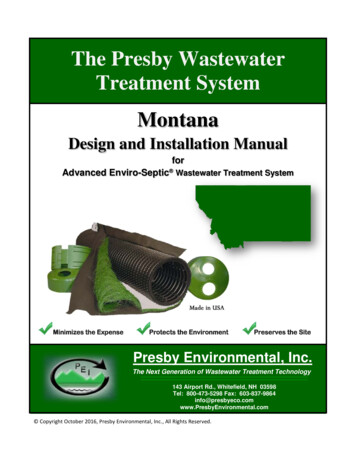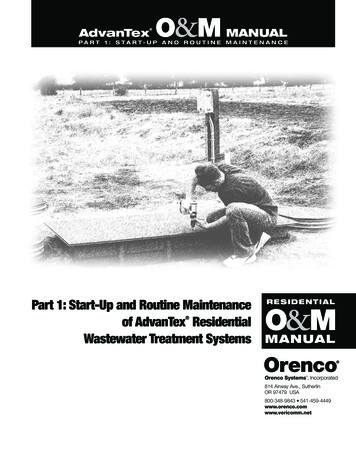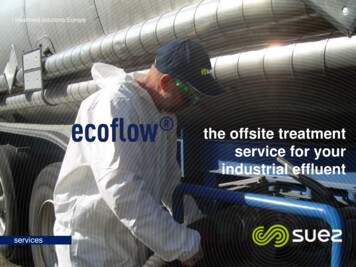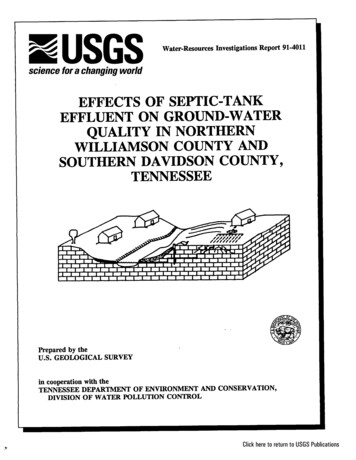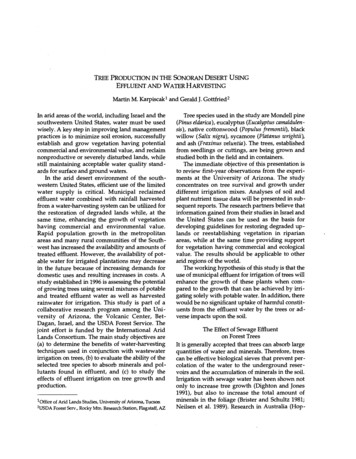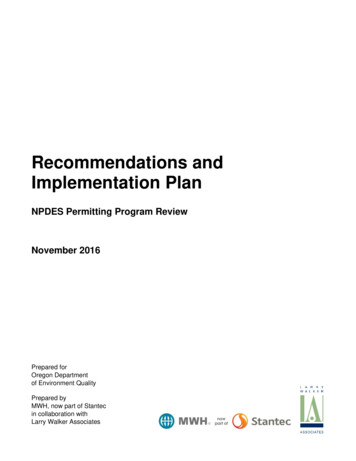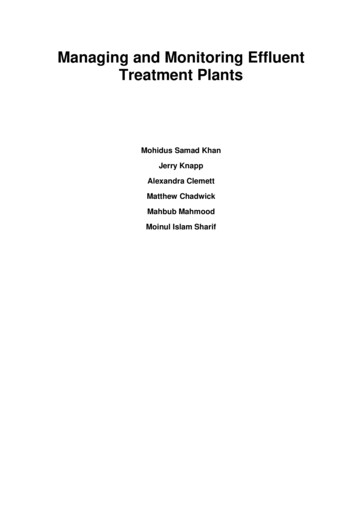
Transcription
Managing and Monitoring EffluentTreatment PlantsMohidus Samad KhanJerry KnappAlexandra ClemettMatthew ChadwickMahbub MahmoodMoinul Islam Sharif
This booklet series has been written by the “Managing Industrial Pollution fromSmall- and Medium-Scale Industries in Bangladesh” Project. The Project isfunded by the Department for International Development, UK under itsKnowledge and Research Programme and the European Commission, underits Asia Pro Eco Programme. The project is also undertaken in collaborationwith the pollution component of the Investment Support to MACH (MACHrefers to the Managing Aquatic Ecosystems through Community Husbandryproject) which is funded by the Government of Bangladesh.The work has been undertaken by the Stockholm Environment Institute, theBangladesh Centre for Advanced Studies and the University of Leeds.More information about the project, including downloads of project documents,can be found at http://www.sei.se/water/beel.Stockholm Environment InstituteLilla Nygatan, 1Box 2142,S-103 14 Stockholm,SwedenTel: 46 8 412 1400Fax: 46 8 723 0348Web: www.sei.seBangladesh Centre for Advanced StudiesHouse # 10, Road # 16A,Gulshan-1Dhaka, BangladeshTel: 8802 8851237Fax: 8802 8851237Web: www.bcas.net1
Contents1Introduction . 22Managing and Monitoring ETP Units . 43452.1Why Manage and Monitor Effluent Treatment Plants?. 42.2Screening . 62.3Equalization . 62.4Neutralization: pH Control . 72.5Aeration . 82.6Coagulation and Flocculation . 92.7Gravity Separation: Clarifier . 22.8Secondary Treatment . 32.9Tertiary Treatment . 72.10Managing and Monitoring Mechanical Equipment . 8When, Where and What to Monitor . 93.1How and when should samples be taken?. 93.2What Tests Should be Conducted? . 103.3Where should Samples be Taken from?. 11Methods for Sampling and Testing . 124.1Sample Collection. 124.2Sample Preservation and Transportation. 144.3Tests Performed at the Factory . 154.4Heavy Metal Test. 184.5List of Equipment . 18Summary. 20Glossary. 212
Acronyms and AbbreviationsASASPBODBOD5CO2CODDFIDDOETPF/M RatioMACHMLSSNaOHSGSSVISVITDSTSSActivated SludgeActivated Sludge PlantBiochemical Oxygen Demand5-day Biochemical Oxygen DemandCarbon dioxideChemical Oxygen DemandDepartment for International DevelopmentDissolved OxygenEffluent Treatment PlantFeed-to-Mass RatioManagement of Aquatic Ecosystems through CommunityHusbandryMixed Liquor Suspended SolidsSodium HydroxideSpecific GravityStirred Sludge Volume IndexSludge Volume IndexTotal Dissolved SolidTotal Suspended Solid3
1IntroductionAll industrial operations produce some wastewaters which must be returned tothe environment. Textile industries produce wastewater, otherwise known aseffluent, as a by-product of their production. Effluent from the textile industryis a major source of environmental pollution, especially water pollution.Among the various stages of textile production, the operations in the dyeingplant, which include pre-treatments, dyeing and finishing, produce the mostpollution. The textile dyeing wastes contain unused or partially used organiccompounds, and high biochemical oxygen demand (BOD) and chemicaloxygen demand (COD). They are often of strong colour and may also be ofhigh temperature. When disposed into water bodies or onto land theseeffluents will result in the deterioration of ecology and damage to aquatic life.Furthermore they may cause damage to fisheries and economic loss tofishermen and farmer, there may be impacts on human health.The rise in the number of industries in Bangladesh, including textile dyeingoperations, has seriously increased the pollution that the country isexperiencing. Consequently national laws have been enacted to protect theenvironment from this pollution. In Bangladesh textile dyeing is categorizedas a Red Category Industry under the Environmental Conservation Act (1995).In accordance with the Act and Environmental Rules (1997) it is mandatory fortextile dyeing factories to install effluent treatment plants (ETPs) to treatwastewater before it leaves the factory premises.International pressure for effluent treatment is also increasing and manyinternational buyers are now showing more concern over whether or nottextiles are produced in an environmentally friendly way. This trend meansthat in the future it is likely that installation and operation of an ETP will beessential to sustain business in the competitive world market.It is a positive sign that many industries are also making progress inestablishing and operating their own ETPs to comply with national andinternational requirements, and also because of increased personalawareness of the negative impacts of industrial effluent.The difficultly that many of these industries face is that effluent treatment isnot part of their daily business as textile manufacturers. However, in order forthese ETPs to function effectively and meet national standards they requireregular and proper monitoring. Untreated and treated wastewatercharacteristics need to be known and must be monitored regularly to evaluatethe efficiency of the treatment plant. Different parameters in different units ofthe ETP also need to be checked to diagnose any internal breakdown of the2
system. It is hoped that this booklet will provide some guidance on whatneeds to be checked and how the checks can be made.This booklet is intended to be read in conjunction with another booklet in theseries, entitled “Choosing an Effluent Treatment Plant”, which providesinformation on the form of wastewater produced by textile dyeing processes,the components of ETPs, the design of ETPs and the national effluentdischarge quality standards defined in the Bangladesh EnvironmentConservation Rules, 1997. The briefing note on “Environmental ClearanceCertificates” also produced in this series may be of additional use.3
2Managing and Monitoring ETP Units2.1 Why Manage and Monitor Effluent Treatment Plants?By law factories must monitor the quality of their wastewater and stay withinnational limits for pollution. The Environment Conservation Rules, 1997provide national standards for the quality of industrial wastewater beingdischarged into certain places including open water bodies, public sewers andirrigated land. They also provide specific discharge quality standards for keyparameters from certain industries, including the textile dyeing industry (Table1).Table 1: Discharge Quality Standards for Classified Industries –Composite Textile Plant and Large Processing Units (Investment overTK 30,000,000)1ParameterLimit (mg/L)pH6.5 – 9Total Suspended Solid (TSS)100BOD5 200C150*Oil and Grease10Total Dissolved Solid (TDS)2100Waste Water Flow100 L/Kg of fabric processingSpecial parameters based on classification of dyes usedTotal Chromium (as Cr molecule)2Sulfide (as S molecule)2Phenolic compounds as C6H5OH5* BOD limit of 150 mg/l implies only with physico chemical processingAlthough the effluent discharged from textile dyeing units varies, it generallyshows pollution indicators of far higher values than the desired level. Pollutionindicator data collected from two industries in Bangladesh demonstrates this(Table 2). These values can vary with different processes as well as typesand conditions of equipment used in the textile industries, but almost alwaysshow greater values than the standards set by the Department of Environment(DoE).4
Table 2: Effluent Water Characteristics of 5 ton Capacity CompositeTextile IndustryParametersLimits forTextileIndustriesmg/l of effluentComposite TextileIndustry withSemi-automaticMachine(Year of sampling 2003)(Year of sampling 2005)g/kg ofmg/l ofg/kg ofmg/l 00100150200***pHWastewater flow6-99.5 -10.5100 l/kg of fabric 125 l/kg of fabricprocessingComposite TextileIndustry withManual 85057.56717035573039044511502159.5 -11150 l/kg of fabricprocessing* No specific standard exists for COD for textile industries but the general standard fordischarge to inland surface water is 200 mg/l.** There is no standard for sulphate but the standard for sulphide is 1 mg/l.To reduce the pollution intensity a proper ETP should be installed on thepremises of the industry to treat the effluent before it is discharged. Theparameters set by the Bangladesh Government must be monitored in theeffluent from the factory to ensure that the factory is complying with nationalstandards.It is also necessary and useful to monitor these parameters in the wastewaterentering the ETP and at several stages in the ETP process. This enables theETP manager to optimize the ETP process by adjusting chemical inputs,retention time and other factors. This can reduce costs by preventing excesschemicals from being used and will result in a more efficient plant thatproduces effluent that complies with national standards. Good ETPmanagement therefore requires a certain level of understanding of the overallfunction of the ETP, how individual units work, how to monitor theirfunctioning, and how to diagnose and address problems.This chapter covers primary treatment, which prepares the wastewaters forbiological treatment, as well as secondary (biological) treatment and brieflymentions tertiary treatments.5
2.2 ScreeningScreening is a mechanical process that separates particles on the basis ofsize. There are several types, which have static, vibrating or rotating screens.Openings in the screening surfaces range in size depending on the nature ofthe waste. In the case of textile dyeing industries they should be smallenough to catch pieces of cloth, which may damage process equipment,reduce the effectiveness of the ETP or contaminate waterways.Managing and MonitoringFor good screening performance the openings of a screen have to be uniform.There should not be any leakage at the joint of the screen and water channel.Textile effluent water is corrosive in nature, so the design of the screen shouldmake allowance for possible corrosion during use. Using corrosion resistantmetal could be a solution but the price is higher than for mild steel.It is highly possible that the openings of the screen will become clogged bypieces of fabric, grit and other particles. It should be monitored and cleanedevery morning and evening so that the flow of effluent is not hampered byblockages.2.3 EqualizationThe many steps in the textile dyeing process (pre-treatment, dyeing andfinishing) mean that wastewater quality and quantity varies considerably overtime, however ETPs are usually designed to treat wastewater that has a moreor less constant flow and a quality that only fluctuates within a narrow range.The equalization tank overcomes this by collecting and storing the waste,allowing it to mix and ensuring that it becomes less variable in compositionbefore it is pumped to the treatment units at a constant rate. The purpose ofequalization for industrial treatment facilities are therefore: To minimize flow surges to physical-chemical treatment systems andpermit chemical feed rates that are compatible with feeding equipment.To help adequate pH control or to minimize the chemical requirementsnecessary for neutralization.To provide continuous feed to biological systems over periods when themanufacturing plant is not operating.To prevent high concentrations of toxic materials from entering thebiological treatment plant.6
Mixing usually ensures adequate equalization and prevents settleable solidsfrom depositing in the tank. In addition, mixing and aeration may result in theoxidation of reduced compounds present in the waste-stream or the reductionof BOD.Managing and MonitoringTo determine the required volume of the equalization tank the hourly variationof flow needs to be determined. Generally the volume of the equalization tankshould be sufficient to collect at least one third of total effluent waterdischarged in 24 hours (i.e. 8 hour retention time).Regular observation is required to ensure that the tank does not overflow or isnot leaking. The mixing and aeration system, if there is one, should bechecked to ensure that it is functioning correctly.Samples should be taken from the equalization tank to determine the qualityof the effluent entering the plant. This will allow adjustments to be made tochemical dosing.2.4 Neutralization: pH ControlWaste from textile industries is rarely pH neutral so the pH in the treatmentprocess should be adjusted to pH 6-8. This is necessary as the bacteriainvolved in biological treatment will not perform effectively outside this rangeand because consumption of chemicals for coagulation and flocculationincreases when the pH is not neutral.Managing and MonitoringThe pH of the water after the equalization tank as well as water aftercoagulation, flocculation and biological treatment, and discharge water shouldbe monitored regularly. For monitoring, a pH meter gives much more accurateresult than pH paper, especially when the effluent is highly coloured, andtherefore pH paper should not be used.An automatic pH controller should be used so that the pH can beautomatically tested and adjusted. If an automatic pH controller system is notfitted samples must be taken regularly (at least every 2 hours) to ensure theefficient functioning of the ETP. Ideally the fitting of an automatic systemshould be considered as it will significantly improve the operation of the plantand will prove to be cost effective.Spare pH meters and electrodes should be kept in stock to replace damagedelectrodes without delay as pH control is crucial to the success of the ETP.7
The pH electrodes used should be selected carefully and should beguaranteed by the manufacturer to be suitable for use in an industrial ETPsince not all electrodes can withstand conditions in an ETP.Usually sodium hydroxide (NaOH) is used to neutralize acidic wastes orhydrochloric acid (HCl) to neutralize alkaline wastes, depending on the normalpH of the equalized effluent. Generally in the dyeing industry in Bangladesheffluents are highly alkaline (high pH) and require the addition of acid.However, provision should be made to be able to add both acid and alkali, assome dyeing processes may give acid effluents and addition of alkali may beneeded. Proper precautions must be taken to protect workers when handlingNaOH, HCl or other chemicals used to correct the pH, as they are stronglycorrosive and potentially dangerous. HCl is corrosive to concrete and steel soprecautions need to be taken to ensure that the acid is not spilt onto the fabricof the ETP.2.5 AerationAeration is required in biological treatment processes to provide oxygen to themicroorganisms that breakdown the organic waste. It may also be applied inthe equalization tank to provide mixing and to reduce oxygen demand byoxidizing the compounds present in wastewater. Two main methods are usedfor this: either mechanical agitation of the water so that air from theatmosphere enters the water; or by introducing air into the tank throughblowers (to supply air) and diffusers (to diffuse the air uniformly).Managing and MonitoringA blower (compressor) is used to supply oxygen (air) during the treatmentprocess. If the blower malfunctions then the treatment process will have to bestopped while the blower is replaced. To overcome this problem a spareblower should be used while the primary blower is being repaired.The aeration unit (diffuser or blower) can be clogged by particles or corrodedby the wastewater, which will reduce the aeration performance. The conditionof the diffusers should therefore be checked every three months. Stainlesssteel diffusers should have a longer life than ones made of mild steel but aremore expensive.Dissolved oxygen (DO) is an important parameter in effluent treatment andshould be measured in the aeration units of ETPs to ensure sufficient oxygenis available for effective treatment. DO is best measured using an oxygenelectrode. Such electrodes are delicate and need careful handling. DOelectrodes that are used in situ in an ETP need to be rated for continual use inthis environment. They need occasional but regular calibration, as per the8
manufacturer’s instructions.replace broken ones.Spare electrodes should be kept in stock toThe 5-day biochemical oxygen demand (BOD5) and chemical oxygen demand(COD) of the effluent after aeration should also be checked regularly to findout how effective the aeration unit is at reducing the oxygen demand. Ideallythis should be every few weeks and no less than every three months.Analysis for BOD5 and COD can only be performed in a suitably equippedlaboratory. An explanation of how to collect and store samples is provided inChapter 4 of this booklet.2.6 Coagulation and FlocculationCoagulation is used to remove waste materials in suspended or colloidal form.Colloids are particles over a size range of 0.1 – 1 nm (10-8 – 10-7 cm). Theseparticles do not settle out on standing and cannot be removed by conventionalphysical treatment processes. In a small sample of wastewater there will beboth settleable solids and dispersed solids. A significant portion of these nonsettleable solids may be colloidal. Each particle is stabilized by negativeelectric charges on its surface, causing it to repel neighboring particles, just asmagnetic poles repel each other. Coagulation is destabilization of thesecolloids by neutralizing the forces that keep them apart so that they canagglomerate 2,3 (come together). This is generally accomplished by addingchemical coagulants and mixing. Figure 1 illustrates how these chemicalsreduce the electric charges on colloidal surfaces.Figure 1: Illustration of Chemical Coagulation 49
The term ‘flocculation’ may be taken to cover those processes whereby smallparticles or small groups of particles form large aggregates. Flocculationduring wastewater treatment converts finely divided suspended solids intolarger particles so that efficient, rapid settling can occur. The term is alsoused for the dramatic effect when polyelectrolytes are added and large stableflocs are formed very quickly (Figure 2).Figure 2: Flocculation by Charge Neutralization and Bridging5Managing and MonitoringCoagulation and flocculation units are designed to reduce the pollution load byremoving total suspended solids (TSS), and reducing BOD5 and COD (sincesome of the suspended solids are organic chemicals and have BOD andCOD). The dosing rate of chemical flocculants and coagulants is relative tothe pollution load, with higher loads requiring higher dosing rates. In practiceETP operators try to determine the pollution load by observing the color ofeffluent entering the ETP. They consider dark wastewater to be more pollutedand light wastewater to be less polluted. Research undertaken as part of thisproject shows that the actual situation is very different. For example at timesthe oxygen demand (BOD and COD) of effluent of a light shade is 1.5 to 2times higher than that of a dark shade. In addition, each inflow, of either light1
or dark shade, mixes with the stored effluent in the equalization tank and thusthe pollution load shows an average value.For effective dosing of coagulant and flocculant the quality of the wastewaterin the equalization tank should be monitored. For optimum dosing the ETPmanager should perform jar tests for different combinations of waste-streams.This is a common laboratory procedure used to determine the optimumoperating conditions for wastewater treatment. The jar test method allowsadjustments to different parameters such as: pH; variations in coagulation orpolymer dose; or alternating mixing speeds, on a small scale in order topredict the functioning of a large scale treatment operation. The results fromthe jar test should be recorded so that in future the ETP operator will knowhow much to dose based on analysis of the effluent in the equalization tank.Once this has been done a few times and effective protocols have beendeveloped then only occasional checking will be necessary.Zeta potential measurements have been used successfully to monitor plantcoagulant dosages. Zeta potential is the voltage difference between thesurface of a suspended particle and the surrounding electrolyte solution.Therefore a zeta potential value indicates a solution in which the particles arenot very dense and long time may require to settle them down. To lower thevalue different types of polyelectrolyte can be used according to effluentcharacteristics. Zeta potential can be measured but observation of results in ajar test remains the best method of coagulant selection.Addition of flocculant and coagulants should be via variable speed meteringpumps so that it is possible to vary the dosing rates accurately. Some ETPoperators vary flow rates by manually altering valves or taps but this isinaccurate and cannot be recommended; using this method it is impossible todevelop standard operating practices to ensure standardized and effectivetreatment. Control of the costs of chemicals is only likely to be achievable ifvariable speed pumps are used and standard practices developed.Samples should also be taken after treatment in the coagulation andflocculation units and tested for colour, TSS, BOD5 and COD. It isrecommended that this is done at least monthly.2.7 Gravity Separation: ClarifierAfter coagulation and flocculation the wastewater is sent to a gravityseparator, clarifier or sedimentation unit to remove any remaining suspendedsolids. Operating conditions that affect gravity separation are:2
Water temperature, which affects both viscosity and density of water.Specific gravity of the oil or suspended solids.Size and shape of suspended oil droplets, and size and shape ofparticles.Settling velocities of particles will change with time and depth, as particlesagglomerate and form larger floc sizes.Managing and MonitoringIf a sedimentation unit is being used for removing flocculated solids, it isimportant that the velocity in the influent channel is kept low, not exceedingabout 0.61 m/sec (2ft/sec) to prevent breakup of flocs. Also if flow velocity ishigh this will cause turbulence which will hinder sedimentation. The surfacearea of a settling tank is one of the most important factors that influencesedimentation. The tank should be sized with a sufficient safety factor toproduce a clarified effluent at minimum water temperature, and to allow forseparating floc particles.2.8 Secondary TreatmentThe objective of secondary or biological treatment of industrial wastewater isto remove, or reduce the concentration of, organic and inorganic compounds.Biological treatment processes can take many forms but all are based onmicroorganisms, mainly bacteria. These microorganisms use components ofthe effluent as their “food” and in doing so break them down to less complexand less hazardous compounds, thus decreasing the BOD and COD. In theprocess the microorganisms increase in number.The two most common forms of biological treatment are: Activated sludge plants (ASPs)Biofilm based systems (often these are trickling filter systems).Activated sludge (AS) is an aerobic flocculent slurry of micro-organisms whichremove organic matter from wastewater and are then removed themselves,usually by sedimentation. Activated sludge is best suited to the removal ofsoluble organic matter because insoluble organic matter can usually beremoved more economically by physico-chemical means. Often, however,wastewaters will contain both soluble and insoluble organic mater.AS leaves the reactor with the treated effluent but is settled out in a clarifierand returned to the aeration unit to recycle the bacteria. The amount of AS3
required for effective operation varies according to the design of the ASP andthe concentration and nature of the effluent being treated. Suppliers of ASPsshould be able to advise on the optimum amount of AS in the system. Theratio of the amount of effluent in terms of BOD and the amount of AS (knownas the f/m ratio) is an important design and operating parameter andsometimes ASPs are operating so as to maintain a fixed f/m ratio. If there ismore AS in the ASP than desired a portion is removed (this is called wasting)and disposed of.A fixed film reactor is a packed bed of media covered with a biological film ofmicroorganisms (slime or biofilm) through which wastewater is passed. As thewastewater passes through the filter, organic matter present in the waste isremoved by the biological film. The trickling filter is a classical design muchused in developed countries; the submerged film reactor is a type of fixed filmreactor that is increasingly being used in Bangladesh.As wastewater passes through the filter, nutrients and oxygen diffuse into theslimes, where assimilation occurs, and byproducts and carbon dioxide (CO2)diffuse out of the slime into the flowing liquid. As oxygen diffuses into thebiological film, it is consumed by microbial respiration, so that a certain depthof aerobic activity is developed (this may be as little as 0.05 mm in depth).Slime below this depth is anaerobic. In a manner similar to activated sludge,BOD removal through a trickling filter is related to the available biologicalslime surface and to the time of contact of wastewater with that surface.In the ‘traditional’ trickling filter, the effluent is tricked over the surface of theslime-covered media and the space between the particles of media isoccupied by air which passively diffuses through the filter (Figure 3). In themore recent design of the submerged fixed film reactor, the particles of mediaare submerged in the effluent and the air is blown into the reactor from below.Both activated sludge and fixed film systems can produce high quality effluentbut both have advantages and disadvantages. In the AS process the settlingand recycling of AS to the aerobic reactor is vital, but the settling process canbe difficult to accomplish. Fixed film systems do not require recycling ofbiomass and so do not present this problem. Surplus AS needs to bedisposed of: this material must be disposed of appropriately so that thepollutants now present in this sludge do not enter the water cycle (see thebriefing note “Management of Textile Dyeing Sludge” produced as part of thisseries for more information on this).The treated liquid is discharged to the environment or taken for furthertreatment depending on the desired standard of effluent quality or the requireduse of the wastewater.4
Figure 3: Mode of Operation of a Trickling Filter 7Managing and MonitoringBiological treatment plants must be carefully managed as they use livemicroorganisms to digest the pollutants. For example some of the compoundsin the wastewater may be toxic to the bacteria used and pre-treatment withphysical operations or chemical processes may be necessary. It is alsoimportant to monitor and control pH as adverse pH may result in death of themicroorganisms and will certainly prevent them from effectively treating thewaste. Ideally the pH should be maintained within pH 6-8.The ETP must be properly aerated and must preferably be operated 24 hoursa day, 365 days a year to ensure that the bacteria are provided with sufficient“food” (i.e. wastewater) and oxygen to keep them alive. Brief breaks (for a fewhours) in operation will probably do little harm but prolonged shut down willdeprive the microorganisms of their food and oxygen and will damage theprocess so that it will not operate effectively when feeding and aeration areresumed.Like humans microorganisms need a “balanced diet” with sources of carbon,nitrogen, phosphorus and sulphur. While textile wastes have enough carbonand sulphur (sulphate) they are generally lacking in nitrogen and phosphorouscontaining compounds. If the microorganisms are to grow and work5
effectively they are likely to need addition of nutrients. Normally materialssuch as urea and ammonium phosphate are added. It is however possible toreplace these nutrients by using the liquid portion of effluent from toilets, whichis rich in nitrogen and phosphorus containing chemicals (it is advisable not touse the solid portion as it may cause operating problems).For proper functioning of the biological unit, the biomass in the reactor and thebiomass in the clarifier need to be monitored regularly. For the ASP thismonitoring is usually done by the mixed liquor suspended solid (MLSS) test,mixed liquor volatile suspended solid (MLVSS) test and examination of themicroorganisms under the microscope. These tests are described in Chapter4. Mixed liquor is the material undergoing aeration in the aeration tank of anASP – it consists o
metal could be a solution but the price is higher than for mild steel. It is highly possible that the openings of the screen will become clogged by pieces of fabric, grit and other particles. It should be monitored and cleaned every morning and evening so that the flow of effluent is not hampered by blockages. 2.3 Equalization

